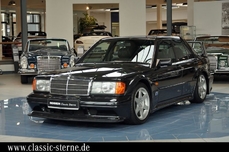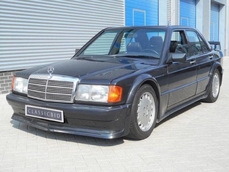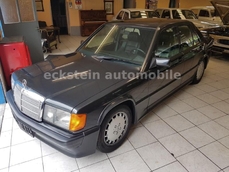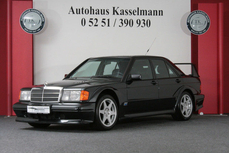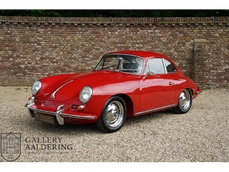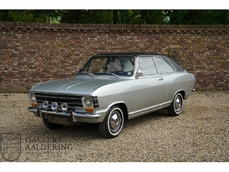Mercedes-Benz 190 2.5-16 1990
General description :
The Mercedes-Benz 190E Evolution 2 is not the completely surprising further development of the successful 190E Evo 1. Whilst the 190E Evo1 had to do with 205 Hp of the 290E 2.5 16V, the Evo 2 had a pleasing 235 Hp. The 190E Evo 2 with its more aggressive looks was not just a stunner to see, it also became a great sales success. Mercedes-Benz sold all 500 in one day! Looking back the Evo 2 illustrates nicely how the DTM would develop in the 90’s. Whereas in the 80’s it was enough to fit a juicy engine in a standard body. The 90’s sounded a new era in. A time when the car became more and more advanced and wilder looking. Over the years they became a lot less in looks like the streetcars they were based on, a development that continues unstopped to this very day. Not only was the evolution from Evo1 to Evo2 about more power and a larger bodykit. Mercedes-Benz had done its homework in the wind tunnel thoroughly. The Evo 2 managed 1st,2nd &3rd place in the 1991DTM. It was rumoured that BMW then had to adjust its wind tunnels to research the effect of larger rear spoilers better. A lesson that Mercedes-Benz had already learnt to its advantage. This specific Mercedes-Benz 190E Evo 2 has been in the same hands for the last 15 years. During this time the car’s speedometer has gone up from 150,000 to 219,000 km. The Evolution models were clearly something different, as Mercedes-Benz could not assemble these cars on the normal 190E production line. Hand-building them was therefor the only option available and that quality build still shows today. The car still feels nearly as solid as the day it left the factory. This Evo 2 shared the garage with an Evo 1, clearly the possessions of a dedicated enthusiast. The picture of an enthusiast’s car is exemplified by the large file of invoices and other documentation and that the car is in a neat condition. Finally the we would like to draw your attention to the fact that this car has been well used, supporting our contention that the owner was a true enthusiast. The bodywork is in a well-used but neat shape with original correctly aligned body panels showing some signs of wear. The “Blauschwartz” metallic paint is neat for its age but also shows some signs of use. The original splitter is included. This specific example is very special. The first 10 examples of the Mercedes-Benz 190E Evo 2 were intended for highest placed directors at Mercedes-Benz AG. As this car is number 008/500 we can safely assume that it is an ex Mercedes-Benz directors car. Mechanically the car has always been well-maintained and therefor still runs extremely well. The interior trim is still very neat considering the car’s age and milage, but does show that it has not lived its life under cloth. The fact that the car has been well used over the years, allows you to drive it to your hearts content without the worry of huge further depreciation. In summary, this is a rare opportunity to buy a 190E Evo 2 in such a condition that encourages you to relive old DTM times on the road. In short, a nice and well-maintained EVO 2, not in new condition but well used. A real car for the real enthusiast! Gallery Aaldering is Europe’s leading Classic Cars specialist since 1975! Always 300-350 Classic and Sportscars in stock, please visit http://www.gallery-aaldering.com for the current stock list (all offered cars are available in our showroom) and further information. We are located near the German border, 95 km from Düsseldorf and 90 km from Amsterdam. So easy traveling by plane, train, taxi and car. Transport and worldwide shipping can be arranged. No duties/import costs within Europe. We buy, sell and provide consignment sales (selling on behalf of the owner). We can arrange/provide registration/papers for our German (H-Kennzeichen, TÜV, Fahrzeugbrief, Wertgutachten usw.) and Benelux customers. Gallery Aaldering, Arnhemsestraat 47, 6971 AP Brummen, The Netherlands. Tel: 0031-575-564055. Quality, experience and transparency is what sets us apart. We look forward to welcoming you in our showroom
http://www.gallery-aaldering.com/mercedes-benz-190-e-evo-2-rare-homologation-special-en
1990 Mercedes-Benz 190 2.5-16 is listed sold on ClassicDigest in Brummen by Gallery Dealer for €139950.
Car Facts
Car type : Car Make : Mercedes-Benz Model : 190 2.5-16 Engine size : 0.0 Model Year : 1990 Sub type : Sedan Location : Brummen
Sold
Seller Information
Sold
People who viewed this Mercedes-Benz 190 2.5-16 also viewed similar Mercedes-Benz listed at ClassicDigest
Other cars listed for sale by this dealer
About Mercedes-Benz
In the annals of automotive history, the journey of Mercedes-Benz is a tale that unfolds with the ingenuity of its founding pioneers. In the year 1886, Karl Benz crafted the Benz Patent Motorwagen, a creation that would go down in history as the world's inaugural automobile. Unbeknownst to him, this moment marked the genesis of what would evolve into the most illustrious premium car manufacturer globally. The financial underpinning of this pioneering venture, interestingly, was provided by Karl Benz's wife, Bertha Benz, demonstrating a remarkable partnership that would set the tone for Mercedes-Benz's legacy.A parallel narrative emerged not far away, as Daimler-Motoren-Gesellschaft, founded by Gottlieb Daimler and Wilhelm Maybach, entered the scene. In 1901, they unveiled their automobile under the now-famous moniker "Mercedes," meaning "godsend" in Spanish. This name was bestowed upon the car at the behest of Emil Jellinek's daughter, the distributor for Daimler-Motoren-Gesellschaft. The wheels of innovation were set in motion.
Fast forward to 1926, a pivotal year that witnessed the merger of Daimler with Benz & Cie., culminating in the birth of Daimler-Benz. The amalgamation saw the adoption of "Mercedes-Benz" as the distinguished trademark for their automobiles, fusing the legacies of two visionary entities into one.
Contrary to perceptions of conservatism, the trajectory of Daimler-Benz unfolds as a chronicle of industry firsts. From the introduction of the honeycomb radiator to the float carburetor, and the pioneering implementation of four-wheel brakes in 1924, Daimler-Benz consistently pushed the boundaries of automotive innovation. The diesel-powered Mercedes-Benz 260 D in 1936 marked the inception of diesel engines in passenger cars. The iconic Mercedes-Benz 300SL Gullwing made history as the first car with direct fuel injection, albeit the Gutbrod's tiny 2-stroke engine can claim precedence.
Safety innovations became a hallmark, with Béla Barényi's patented safety cell design in the "Ponton"-models in 1951, featuring front and rear crumple zones. The W116 450SEL 6.9 saw the introduction of the Anti-Lock Brake system (ABS), another pioneering safety feature. From the first production airbags and beyond, the legacy of "firsts" continued to be etched into the fabric of Daimler-Benz.
Over its centennial journey, Mercedes-Benz has not merely produced cars but has sculpted automotive icons. The SSKL, 710 SSK Trossi Roadster, 770K Grosser, 540K Spezial Roadster, 300SL Gullwing, w100 600 Pullman, w111 280SE 3.5 Flachkühler, w113 230SL Pagoda, w109 300 SEL 6.3, and w201 2.3-16 Cosworth stand testament to the brand's commitment to engineering excellence.
The roaring Silver Arrows, or "Silberpfeile," including the W 25, W 125, W154, W165, and W196, created a legacy of dominance on the racetrack. These machines were not merely cars; they were expressions of precision, speed, and an indomitable spirit that left their competitors in the dust.
As Mercedes-Benz marches into the future, it does so not just as an automaker but as a custodian of a legacy, a torchbearer of innovation, and a beacon of automotive excellence. The road ahead is sure to witness the continued fusion of cutting-edge technology, timeless design, and an unwavering commitment to setting new standards in the world of automobiles.
One luminary figure who left an indelible mark was Béla Barényi, often heralded as the "father of passive safety" for his pioneering work in safety engineering. His patented safety cell design, featuring front and rear crumple zones, became a hallmark of Mercedes-Benz's commitment to occupant safety, setting new standards that reverberated throughout the automotive world.
Moving through the chronicles, the collaborative genius of Wilhelm Maybach, alongside Gottlieb Daimler, laid the foundation for Daimler-Motoren-Gesellschaft. Their innovations not only birthed the first Mercedes but established a culture of relentless pursuit of technological excellence that remains integral to Mercedes-Benz's DNA.
In the post-merger era of 1926, Ferdinand Porsche emerged as a prominent figure within Mercedes-Benz. His work on the Mercedes-Benz S-Type, a supercharged race car, garnered acclaim and set the stage for a legacy that extended far beyond the marque. Porsche's impact would later extend to his eponymous company, but his influence at Mercedes-Benz during those formative years was pivotal.
As the 20th century progressed, the legendary Rudolf Uhlenhaut emerged as a key figure. Uhlenhaut, an accomplished engineer and the driving force behind the iconic Silver Arrows, played a crucial role in Mercedes-Benz's dominance in motorsports. His engineering prowess and attention to detail were instrumental in creating some of the most formidable racing cars of the era.
In the latter half of the century, figures like Bruno Sacco, the head of design at Mercedes-Benz from 1975 to 1999, left an indelible imprint on the brand's aesthetic identity. Sacco's design philosophy, characterized by clean lines and timeless elegance, shaped iconic models like the W126 S-Class and the W201 190E, solidifying Mercedes-Benz's reputation for luxury and sophistication.
The narrative would be incomplete without acknowledging the contributions of engineers like Hans Scherenberg, whose leadership in the 1970s ushered in a new era of technological innovation at Mercedes-Benz. Scherenberg's tenure saw the development of groundbreaking technologies, including the Anti-Lock Brake system (ABS) and the introduction of airbags in production cars.


